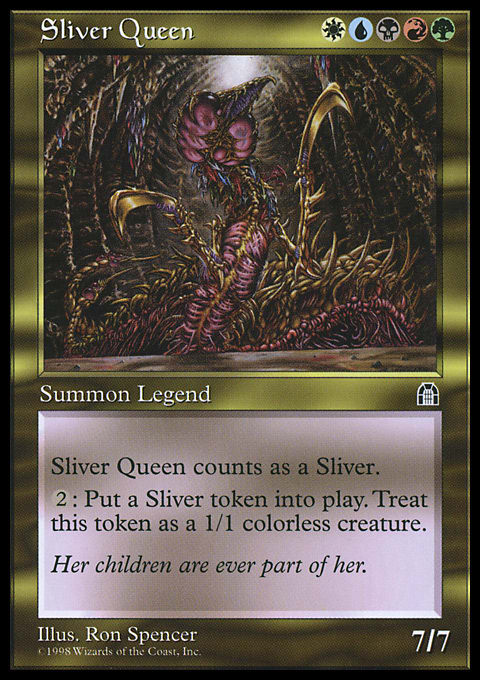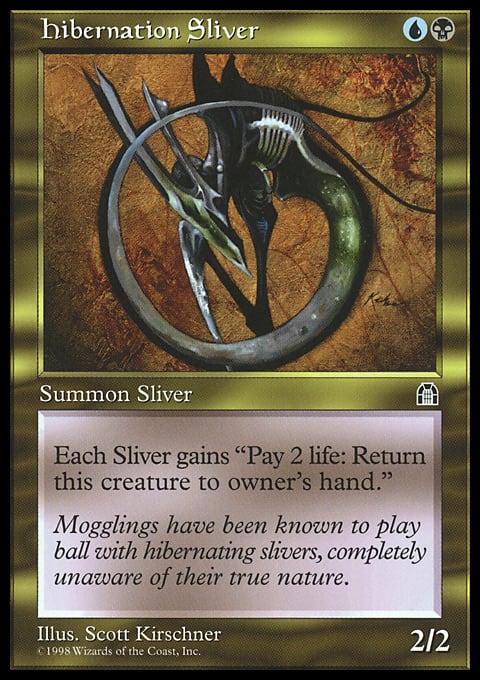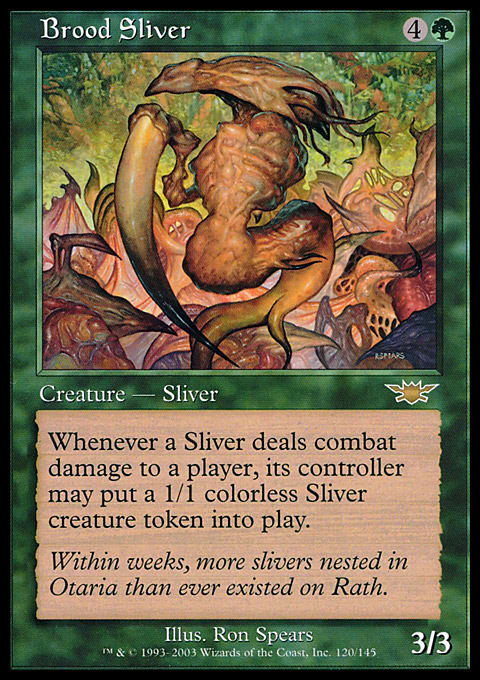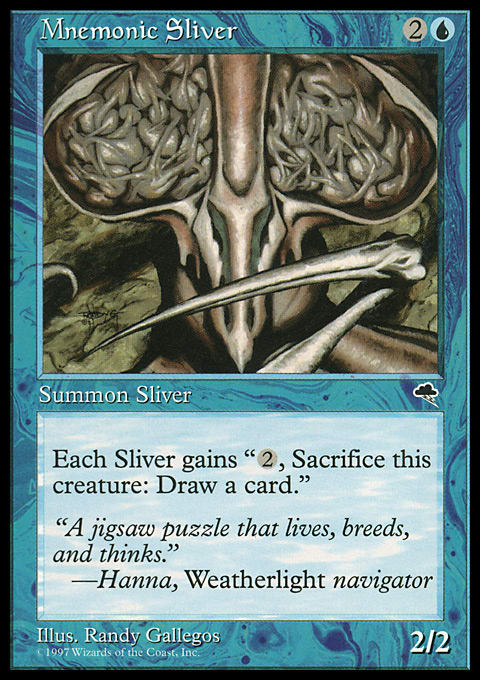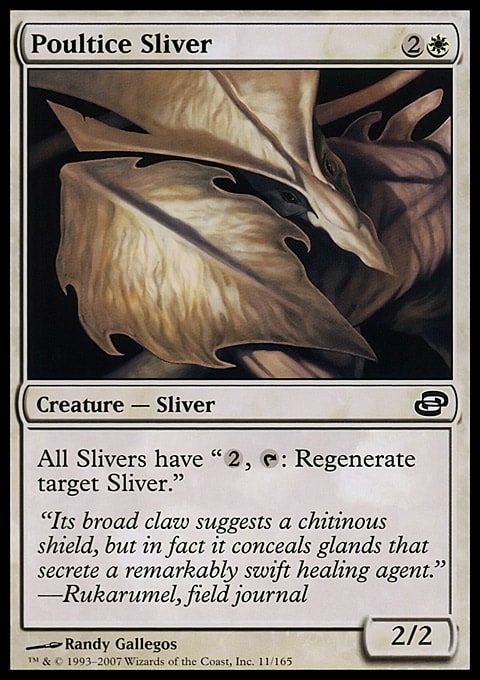Sliver Queen
One of the first stories I learned in Magic was of Karn the Silver Golem and the Sliver Queen.
The Legacy, mysterious and powerful artifacts (uh, in-narrative at least) that will eventually combine to be the ultimate weapon, has been stolen away by the evil Volrath, and the crew of the airship Weatherlight have traveled to the world Rath to get them back. The Legacy, it turns out, is being guarded by the Sliver Queen, the nexus of the whole strange sliver hive organism.
Karn encounters the Queen and negotiates with her. He demonstrates to her that the Legacy artifacts fit inside of him the same way that her slivers are part of her being. Recognizing their similarity, the Queen relinquishes her hold on the artifacts and lets Karn go.
The story has a mythic quality to it, almost a fairy tale or fable, but one without a straightforwardly human moral. The characters learn something about themselves . . . but it's something that's simply not that applicable to human life. Oh, sure, we could torture the narrative until it's about accepting all parts of yourself, or group cohesion, or something, but the nature of the slivers and the Legacy -- individual bodies that form a gestalt, distributed consciousness -- is pretty far removed from human subjectivity.
Ron Spencer's characteristically gristly artwork fits this idea well. Spencer's art always looks like it's crawling with tentacles or maggots or grotesquely corded muscles. That can sometimes result in pretty uncanny looking humans. On the Queen it's still uncanny but undeniably fitting. The nexus of a gestalt flesh-telepath organism should probably look like it's formed of a bunch of different segments (and the queen, notably, is covered in her children, roosting like bats!) and Spencer's deliciously, monstrously tactile style, full of bumps and ripples and fleshy crevices, delivers.
Karn and the Queen are like two impossibly advanced siphonophores, gestalt organisms all working as a whole. The original sliver ability template -- where all slivers on the battlefield, yours and your opponents', shared their abilities -- reflects the strangeness of this arrangement: individual bodies might be press-ganged by one Planeswalker or another, but there is only one hive, one organism.
Maybe if I say this sounds strangely lonely you'll think me too anthropic. Still, even if I'm projecting my own values onto something that really is fundamentally alien in how it engages the world, I can't help but think of Karn's meeting with the Sliver Queen as a story of two profoundly unique entities, isolated even as they are surrounded by themselves, finding some companionship with their similars. Their connection with each other is something we might only be able to glimpse from a distance, through metaphor.
Hibernation Sliver
Of the three Scott Kirschner slivers, Hibernation Sliver is probably the best looking. Subtle greens and purples offset the gold card border which seems to extend into the abstract, mottled background. The sliver itself is elegantly curled, but its horns and spines jut out at visually interesting angles, almost like the hands of a clock. It's a great example of abstraction in fantasy art.
Hibernation Sliver has two close cousins, Armor and Barbed varieties. They almost seem like a sub-breed unto themselves (maybe related to Terese Nielsen's translucent Victual Sliver), with black and grey flesh, thick tails, and a striking exposed ribcage-like form. I'm not sure it can be called a ribcage, exactly, it's so obviously different than Earthly vertebrate body plans. Rather than a central spinal column, these slivers seem to have two columns to either side of this ribcage. Everything about them seems strangely backwards -- two spines and tails where vertebrates have one, one centered limb where vertebrates have two.
Kirschner's abstraction, far from obscuring this detail, makes the strangeness of the sliver body plan all the more apparent. The pieces are nearly schematic, flat, strategic and minimal in their use of dimensional shading. They are all the more alien for their style.
Brood Sliver
The slivers of Otaria aren't quite as varied as those we see elsewhere in Dominia. Oh, they've got plenty of individual breeds, to be sure, there's just something about this crop that strikes me as a bit more homogeneous than earlier and later broods.
Of course, the slivers of Otaria don't have a lot to work with. After the events of the Phyrexian Invasion, there weren't any slivers left, after all. They survived only as fossils in Urborg.
That was enough for the Riptide Project to work with, though. The project, the first major attempt at revived scholarship in post-apocalyptic Dominaria, attracted wizards from all over the plane. Eventually, one of the sliver remains made its way to Riptide and the creature was cloned.
The rest is (totally awesome) history. The Riptide wizards, fascinated by these queenless creatures, this living body without its head, pushed their subjects further and further, until the slivers developed enough adaptations to overrun the island completely. Just like Arcum and his Phyrexian relics. And the Order of the Ebon Hand and their thrulls. And the Sarpadian elves and their Thallids. Hey, this sure happens a lot in Magic!
The function of the Queen must have been to help grow the swarm. That's her ability, after all. But her function also seems to have been to regulate the hive's growth. The Queen, after all, adds slivers one at a time. Brood Sliver, though, simply turns all available food into more damn slivers, growing the hive to a greater size than their Rathi progenitors.
The slivers of the Riptide Project perhaps simply don't need to have as much morphological variance as they did in other eras and worlds. Otaria, locked in the mayhem of Karona's nonsense and the Mirari's manipulations, had no way of stopping the onslaught that was coming. The Riptide slivers needed merely to develop those adaptations best suited to flooding Riptide and the rest of the continent.
They would have plenty of time -- and ample numbers -- to adapt when the land turned to salt and life on Dominaria became a desperate arms race for survival amid the ravages of the time rifts.
Mnemonic Sliver
I'm not sure how literally we're to take Mnemonic Sliver's art. Maybe that's a flaw. Certainly every time I see the art I expect it to create tokens of some sort. But no, instead, "all Slivers have '2, Sacrifice this permanent: Draw a card.'" The flavor text, a quote from Weatherlight's navigator Hanna explains this evocatively, describing the whole sliver hive as "a jigsaw puzzle that lives, breeds, and thinks."
Is this what Mnemonic Sliver really looks like literally, then, or should we take this as a figurative image, the sliver's massive brain visualized as that jigsaw of entities, greymatter made up of interlocking bodies? I mean, it's totally possible it really does just have a bunch of half-formed sliver bodies writhing around in/as its brain. That would be pretty weird but pretty awesome, and truly, deeply alien. The brain of such an alien, fractal entity might have such an uncanny, liminal appearance, halfway between brain wrinkles and budding eggs.
Either reading makes some sense with the history of sliverlore. Mark Rosewater relates that Mike Elliott, father of slivers, originally conceived them as being components of a single being that had been split apart in a magical duel. Obviously the slivers we got after "Astral Ways," Elliott's fan set, was polished into Tempest Block are quite a bit different from this vision. They bring in zooid biology to replace the mythic background of Elliott's splintered guardian figure. The sense of parts fitting into a whole remains.
Mnemonic Sliver seems to develop all slivers into a kind of distributed processing network, a fleshy calculator that lets the hive burn out component parts in order to increase knowledge. This makes sense as an extension of the slivers' telepathic connection which allows them to share their very morphology . . . except that, actually, the slivers aren't really telepaths. Not according to Rei Nakazawa, at least. Way back in 2004, after the second generation of slivers arrived on Otaria, Nakazawa wrote that, rather than communicating through telepathy, slivers "can 'read' other Slivers with complete accuracy. Each individual is born with certain qualities or powers, and when another Sliver 'reads' this Sliver, it can share those powers."
This is a much weirder flesh-telepathy. The cartesian division between 'body' and 'mind' is totally messed up through this unexplained "reading" that transmits communication seemingly through the warping of the body.
If Mnemonic Sliver represents the introduction of distributed sliver computing, it might do so not by leveraging sliver minds but sliver bodies. Is that why slivers must be sacrificed to it, their whole bodies given up to allow for computational changes of state?
Randy Gallegos's art for this card might be a literal, physical depiction of this sliver, or it might be a more symbolic representation. The creature itself, and slivers as a whole, might call into question whether the distinction between those things truly matters.
Poultice Sliver
What a weird looking sliver! I mean this really jumps out as something different, doesn't it?
I mean . . . it's got eyes!
Or, maybe those are eyes. It's kind of hard to say. They LOOK like eyes . . . but this sliver also has a claw that looks like a leaf, which, come to think of it, is also a little odd. That leaf claw seems to be a shield, but as Rukarumel points out in the flavor text, that's actually a misinterpretation of what we're seeing. The big leaf shape "in fact . . . conceals glands that secrete a remarkably swift healing agent." Huh.
The flavor text feels a bit like a patch, like maybe the art was for a more defensive sliver and the mechanics shifted mid-development to regeneration and they fixed it in the flavor text. I kind of love its patch job feel, though. It feels true to life, like an actual naturalist attempting to make sense, through observation, of an undiscovered animal's strange behaviors.
We can speculate and draw ideas from inference about what we're looking at with Poultice Sliver, but it's hard to say anything definitive. Is the large leaf shape designed to better spread this healing salve? Or does the sliver in fact offer TWO adaptations -- the gland as a fallback defense if the camouflage of its leaf-mimicking form fails? We know other slivers imitate plant life, or copy the morphology of other animals -- Darkheart Sliver, for example, or Virulent Sliver. Are those, in fact, eyes that it's developed, or is this some other gland, some other sensory organ? It's impossible to say without slivers actually being, you know, real, and observable, but it's fun to speculate.
Part of that fun, I think, comes from the way slivers present consistently familiar-but-alien forms. The slivers have their strange, iconic, and dare I say beloved body plan, but that body plan can be twisted quite dramatically to new ends. This means though that the slivers must develop solutions for evolutionary problems from a radically different starting point than more familiar animals, one that includes sense organs that probably depend on actual magic to work. Is Two-Headed Sliver, for example, actually two slivers sort of merged together to ape the body plan of more conventional vertebrates (while, apparently, getting sidetracked into developing arthropod legs)?
Seeing how the strange bodies of the slivers contort and change to solve new environmental challenges is one of the slivers' core appeals.













